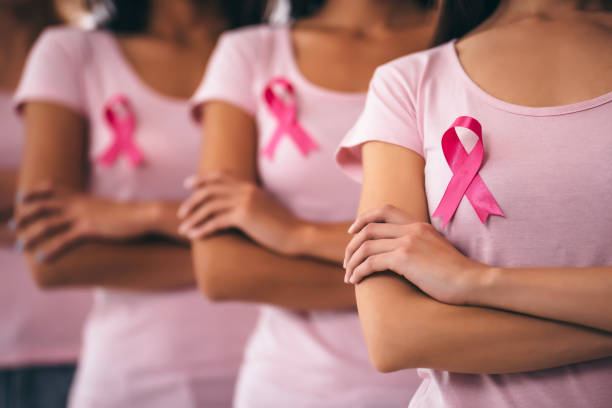Globally, breast cancer is the most frequently diagnosed form of cancer. According to the World Health Organization, in 2020, there were 2.3 million women diagnosed with breast cancer, 7.8 million women alive who were diagnosed within the last five years, and 685,000 deaths worldwide. Breast cancer awareness is pivotal in the early detection of cases which could help to save lives.
Locally, breast cancer is the most common cancer among women in Singapore, accounting for 1 out of every 4 to 5 cancers. The prevalence of breast cancer over the last 30 years is on the rise and one out of every twenty women will develop breast cancer in her lifetime.
What is Breast Cancer?
Breast cancer is a disease in which cells in the breast grow out of control. Typically breast cancer emerges in the lining cells (epithelium) of the ducts, but also occurs in the lobules in the glandular tissue of the breast. Initially, the cancerous growth is confined to the duct or lobule where it generally causes no symptoms and has minimal potential for spread (metastasis).
Over time, these confined cancers may progress and invade the surrounding breast tissue (invasive breast cancer) and then spread to the nearby lymph nodes (regional metastasis) or other organs in the body (distant metastasis).
Signs and Symptoms of Breast Cancer
Breast cancer most commonly presents as a painless lump or thickening in the breast. Other signs to watch out for are changes in size, shape, or appearance of a breast; dimpling, redness, pitting, or other alteration in the skin; change in nipple appearance or alteration in the skin surrounding the nipple (areola); and/or abnormal discharge.
There are many reasons for lumps to develop in the breast, most of which are not cancer. As many as 90% of breast masses are not cancerous. Non-cancerous breast abnormalities include benign masses like fibroadenomas and cysts as well as infections.
Breast cancer can present in a wide variety of ways, which is why a complete medical examination is important. Women with persistent abnormalities (generally lasting more than one month) should undergo testing including imaging of the breast and, in some cases tissue sampling (biopsy) to determine if a mass is malignant (cancerous) or benign.
Breast Cancer Risk Factors
The main risk factor for breast cancer is being born female. Men can also get breast cancer, but the disease is much more prevalent in women. Getting older also increases your risk for breast cancer as most breast cancers are found in women aged 55 or older. Certain hereditary traits increase risk as well. About 5% to 10% of breast cancer cases are thought to be hereditary, meaning that they result directly from gene changes (mutations) passed on from a parent.
The most common cause of hereditary breast cancer is an inherited mutation in the BRCA1 or BRCA2 gene. In normal cells, these genes help make proteins that repair damaged DNA. Mutated versions of these genes can lead to abnormal cell growth, which can lead to cancer.
On average, a woman with a BRCA1 or BRCA2 gene mutation has up to a 7 in 10 chance of getting breast cancer by age 80. This risk is also affected by how many other family members have had breast cancer. (It goes up if more family members are affected.) Women with one of these mutations are more likely to be diagnosed with breast cancer at a younger age, as well as to have cancer in both breasts.
There are other gene mutations that can also lead to inherited breast cancers. These gene mutations are much less common, and most do not increase breast cancer risk as much as the BRCA genes.
Genetic Testing
To definitively know you possess these hereditary mutations, genetic testing is available. Genetic testing for hereditary breast and ovarian cancer looks for mutations in the BRCA1 and BRCA2 genes. Usually, genetic testing is recommended if you:
- Have a family health history of breast and ovarian cancer
- Have a personal history of breast cancer, and meet certain criteria (related to the age of diagnosis, type of cancer, presence of certain other cancers or cancer in both breasts, ancestry, and family health history),
- Have a personal history of ovarian, fallopian tube, or peritoneal cancer
- Or have a known BRCA1, BRCA2, or other inherited mutation in your family.
How to Prevent Breast Cancer
Unfortunately, there is no definite way to prevent breast cancer, but there are many lifestyle changes you can make that may lower your risk.
It is important to maintain a balance of a healthy diet, sufficient rest, and exercise. Studies show that increased consumption of cruciferous vegetables (bok choy and other cabbages) and dark leafy greens (kang kong) in your diet may help reduce your risk of cancer. Maintaining a balanced diet is also important as deficiencies in certain vitamins and minerals increase cancer risk, especially a deficiency in Vitamin D.
You can avoid excessive alcohol consumption and abstain from tobacco use to help reduce your risk and speak to your doctor about certain types of birth control or hormone replacement therapy that can contribute to an increased risk of breast cancer.
The Importance of Regular Breast Exams and Testing

Early intervention is key
Women should do a breast self-exam once a month, every month. Women who are still menstruating (having a regular period) should perform a breast self-exam (BSE) after their period, as during this time breast tissue enlarges preparing for a possible pregnancy, making a BSE ineffective. Women who have stopped menstruating and those who have very irregular periods can pick a day each month. Choose a day that is consistent and easy to remember, like the first day of the month, the last day of the month, or your favorite number.
Performing a monthly breast self-exam will help you maintain breast health and detect early signs of disease. With each BSE, you will become more familiar with your body. When you know what’s normal for you, you can be more aware of when changes occur.
Self-exams are important for breast health. But they should not replace exams and screening tests (such as mammograms) recommended by doctors. You should still see your primary care provider and/or gynecologist regularly.
If you have any questions or concerns about your own personal risk of breast cancer, speak with a doctor on our panel who can advise if you should get a genetic test done.
Check out our other precision health test kits here
References
- Centers for Disease Control and Prevention. (2022, September 26). Breast Cancer. Retrieved October 24, 2022, from https://www.cdc.gov/cancer/breast/index.htm
- Centers for Disease Control and Prevention. (2021, September 9). Hereditary breast and ovarian cancer. Retrieved October 24, 2022, from https://www.cdc.gov/genomics/disease/breast_ovarian_cancer/index.htm
- Cleveland Clinic. (2021, January 9). Breast self-exam: How to perform, what to look for. Retrieved October 24, 2022, from https://my.clevelandclinic.org/health/diagnostics/3990-breast-self-exam
- Health Promotion Board, Ministry of Health. (2005, April). Breast Cancer. Singapore.
- World Health Organization. (2021, March 26). Breast cancer. Retrieved October 24, 2022, from https://www.who.int/news-room/fact-sheets/detail/breast-cancer





